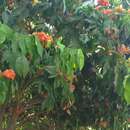en
names in breadcrumbs


Saraca indica, commonly known as the asoka tree, ashok or simply asoca,[2] is a plant belonging to the subfamily Detarioideae of the family Fabaceae. The original plant specimen from which Carl Linnaeus described the species came from Java, but the name S. indica has been generally incorrectly applied to S. asoca since 1869.[3] It can be distinguished from S. asoca by its non-clasping bracteoles, a lower number of ovules, slightly smaller pods, and a more eastern geographic distribution.[4]
The seeds are eaten by monkeys and squirrels, and Thai people eat the flowers and leaves of one variety of the species.[5]
Saraca is sometimes confused with the false ashoka, Monoon longifolium, which is a lofty evergreen tree native to India. It exhibits symmetrical pyramidal growth with willowy weeping pendulous branches and long narrow lanceolate leaves with undulate margins. The false ashoka tree is known to grow over 30 ft in height.
Saraca indica, commonly known as the asoka tree, ashok or simply asoca, is a plant belonging to the subfamily Detarioideae of the family Fabaceae. The original plant specimen from which Carl Linnaeus described the species came from Java, but the name S. indica has been generally incorrectly applied to S. asoca since 1869. It can be distinguished from S. asoca by its non-clasping bracteoles, a lower number of ovules, slightly smaller pods, and a more eastern geographic distribution.
The seeds are eaten by monkeys and squirrels, and Thai people eat the flowers and leaves of one variety of the species.
Saraca is sometimes confused with the false ashoka, Monoon longifolium, which is a lofty evergreen tree native to India. It exhibits symmetrical pyramidal growth with willowy weeping pendulous branches and long narrow lanceolate leaves with undulate margins. The false ashoka tree is known to grow over 30 ft in height.
Saraca indica est une espèce de plantes dicotylédones de la famille des Fabaceae, sous-famille des Caesalpinioideae, originaire de l'Asie du Sud-Est, de l'Indochine à la Malaisie[2].
C'est un arbre aux feuilles composées pennées et aux fleurs apétales, au calice tubulaire à quatre lobes rouge-orangé, groupées en panicules corymbeuses.
Selon The Plant List (10 novembre 2018)[1] :
Selon Tropicos (10 novembre 2018)[3] (Attention liste brute contenant possiblement des synonymes) :
Sara indica, Jardin botanique de la reine Sirikit, Thaïlande
Saraca indica est une espèce de plantes dicotylédones de la famille des Fabaceae, sous-famille des Caesalpinioideae, originaire de l'Asie du Sud-Est, de l'Indochine à la Malaisie.
C'est un arbre aux feuilles composées pennées et aux fleurs apétales, au calice tubulaire à quatre lobes rouge-orangé, groupées en panicules corymbeuses.
Saraca indica L., 1767
Сарака индийская (лат. Saraca indica) — типовой вид растений рода Сарака (Saraca) семейства Бобовые (Fabaceae).
Впервые описанные Карлом Линнеем, во втором издании работы Mantissa Plantarum, образцы этого вида прибыли в Европу с острова Ява.
В некоторых источниках название Saraca indica ошибочно применяется близкородственному виду Ашока (Saraca asoca), неточность впервые возникла в публикации 1869 года.[2]
От ашоки сарака индийская отличается иными деталями строения цветка, чуть меньшим количеством стручков, и восточнее расположенным ареалом.[3]
Синонимы:
Сарака индийская (лат. Saraca indica) — типовой вид растений рода Сарака (Saraca) семейства Бобовые (Fabaceae).
Впервые описанные Карлом Линнеем, во втором издании работы Mantissa Plantarum, образцы этого вида прибыли в Европу с острова Ява.
В некоторых источниках название Saraca indica ошибочно применяется близкородственному виду Ашока (Saraca asoca), неточность впервые возникла в публикации 1869 года.
От ашоки сарака индийская отличается иными деталями строения цветка, чуть меньшим количеством стручков, и восточнее расположенным ареалом.
Синонимы:
Jonesia minor Zoll. & Moritzi Saraca arborescens Burm.f. Saraca asoca sensu auct. Saraca bijuga Prain Saraca harmandiana Pierre Saraca kunstleri Prain Saraca lobbiana Baker Saraca minor (Zoll. & Moritzi) Miq. Saraca pierreana Craib Saraca zollingeriana sensu Prain, non Miq.